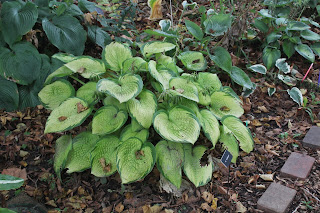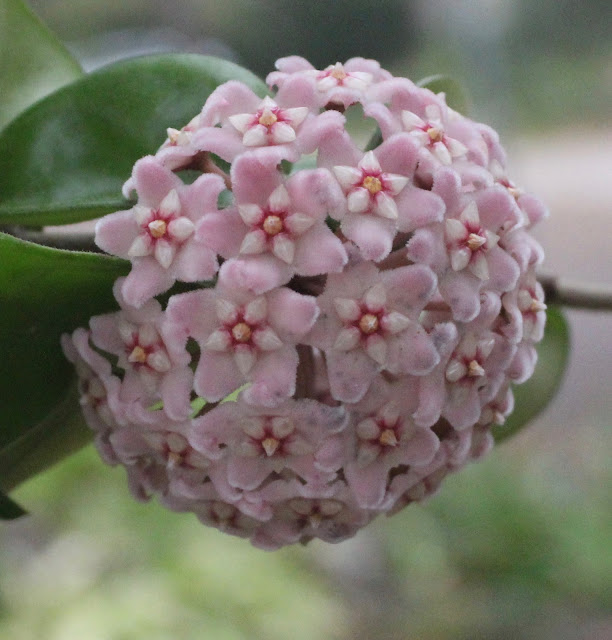We had over an inch of rain on Tuesday. That was in addition to the third of an inch last Saturday. The rain on Tuesday was more rain than the entire month of September. I am thinking that maybe I can just put away the hoses for the year. (There is a front yard hose and a back yard hose.) We have actually been fortunate the last few years as to rain. There were several years when I did not have to get out the hose at all.
One word for the garden these days is quiet. Not much is going on. I am gathering the plants together for the plant migration inside. Each day when we go to work, we take a few plants. We have a plant light stand at the office. In addition we have four offices that have south windows with nice window sills.
The leaves are falling. Is that why they call it "fall"? We have 5 very mature trees in the yard. They all have lots of leaves. In alphabetical order there is a Buckeye Tree, an Elm Tree, a Linden Tree, a Sycamore Tree, and a Walnut Tree. They lose their leaves at different times. We have to rake leaves for months.
Last Week's voting
The top vote getter last week was the Silk Road Ascelpias. I made rootings of this plant all last winter. I must have set out several dozen plants grown that way. Most of those plants are blooming at the end of about a three foot single stem. There was absolutely no side shoots or other clumping. On the other hand there are lots of seedlings starting to grow. These are not perennials. Sometimes gardens have to make harsh decisions.
The full vote count was:
Silk road Ascelpias 9
yellow hibiscus 7
Blue monkshood 4
Air plant 3
Hibiscus closeup 3
orange zinnias 3
Hoya jewels 3
red abutilon 2
purple zinnia 2
This Week's Pictures
#1 Full Hoya globe
This is the cluster that was a bud last week. Like many of the pictures this week, I think this is a much better picture than what you saw last week.
I am so pleased that it bloomed now.
I repotted the plant this summer and it seems to be thriving.
It does make me think about getting more hoyas.
#2 Croton, variety Petra
I have four of these nice big potted plants. The variety is Petra. They are the most common Croton, always on sale at the grocery store. Put together they make a wonderful display. I would like to make a jigsaw puzzle out of this picture.
#3 Gingerland Caladium
These big leaves suffered during the dry hot time. They also fade as the temperature drops below 50. I now have to decide whether to dig the bulbs and keep them for next spring.The alternative is to just get new ones at that time.
#4 Bouganvillia
I cannot wait for the first really sunny day. This plant is starting to put on a show.
#5 A single monkshood
This picture lets you almost see the face and its elaborate hat.
Bonus Pictures
Some flowers are interesting when they are way past their prime.
This is the white anemone.
It leaves the yellow seed pods.
Remember the little air plants Pat sent me from Florida in early July?
Let me take you through the blooming and then show you the plant now.
This is what they looked like when I got them. There were several of them. This is July 1.
This is July 4.
This is July 12.
This is yesterday, October 14. Note the seed pod on the right. I have spent some time thinking about what you would do with air plant seeds. Actually I assume if you were crazy enough to grow them from seed you would plant them, like orchids, in some kind of very light medium, which would replicate being grown in a part of a tree, where it is very humid.
There is new growth coming down by the center.
If I knew more about these plants I would know how much of the old growth to keep.
Here is this little toy on my computer I just discovered. It is a magnifying glass circle. You can see the new growth better.
At this time of year some hosta still look good. Here are three hosta to give you an idea.


Here are the many varieties of Crotons I have. With little leaves, which in one case, is grass like, they do not photograph well.






Julia's Recipe
Apple Butter
Apple butter starts like applesauce. I had about 4 pounds of apples from our current favorite farmer's market orchard. I cut the apples in quarters and cut out the stems and the blossom ends. That's it: no peeling, no coring.
I added about 1/2 cup of water and cooked the apples until they had given up, as at right. This took about 1 hour on medium-low heat, and I checked the pot from time to time to give the apples a stir and to make sure they were not sticking to the bottom of the pan. If they stick, add more water. The length of time the apples take to reach the stage of giving up depends mostly on the nature of your apples. Some take longer. Let them cook until they had disintegrated.
Next, I pulled out my conical sieve and set it over a bowl, near the pot of disintegrated apples. I like the conical sieve. One moves the wooden pestle-like instrument around and the apple pulp comes out the sides through the little holes. The seeds and skin and other unappetizing bits stay in the sieve and can be discarded.
It is because I sieve the pulp that I do not need to pare or core the apples.
Here is a close-up of the rig. When the bowl had some strained pulp in it, I poured the pulp into another pot - oven-safe enamelware. I ended up with about 4 or 5 cups of sieved pulp. By the way, periodically, I did need to scrape the pulp off the outside of the sieve and then scoop the debris out of the inside into a compost bowl. The debris does pile up inside the sieve.
Here is the enamelware pot of apple pulp. I stirred in 1 cup of sugar and 1/2 teaspoon of cinnamon. Then I put the pot in a 300 degree oven and let it bake gently until the apple stuff had reduced by half, which took a couple of hours, during which time the house smelled very nice, apple-y and cinnamon-y. And that's apple butter.
Instead of the long, slow bake, you could cook the pulp, sweetened and spiced, on the stove-top for 10 or 15 minutes, let it cool and put it into containers of some kind and you would have very tasty applesauce, which freezes well. Apple butter is applesauce, reduced to a thick brown confection by long cooking.
We canned the apple butter using the usual protocol: 1/2 pint jars washed and dried in the dishwasher; screwbands at the ready; new canning lids in a small pan and brought to a boil then turned off; bubbling apple butter ladled into the jars; jar tops wiped clean with a wet paper towel; canning lids affixed with screwbands; jars turned upside down on a tea towel to cool and seal. Here they are, all done.
A few notes: if you do not have a conical sieve, you can still make applesauce or apple butter. You will have to peel and core (and quarter) the apples at the beginning. Instead of sieving them to get to the pulp stage, you can mash them very thoroughly or process them (after letting them cool down some) in a food processor. I am not sure whether a blender would work well. The amount of sugar can be varied, depending on your taste and the nature of your apples: some apples are sweeter than others. Some apples will take a long time to disintegrate: Granny Smith, for example. It is fine to use a combination of apples. If you do not like cinnamon, try a little orange rind or a little cloves or a little nutmeg. Go lightly with spices, as their flavors will intensify with cooking and in storage. I do not know why flavors intensify when the apple butter is bottled up and on the shelf. Probably science. Instead of water at the beginning, you might use apple juice or apple cider or orange juice or white wine. Apple butter is good on toast, of course, but it is also good with plain yogurt or with vanilla ice cream. Play around!
Odds and Ends
We had more rain yesterday. It does seem to go in cycles.
Gardening was held to a minimum.
The pictures this week would have been better if there was sunshine. It is scheduled to return soon.
One of the taller hibiscus, an older one, did not look as full as I had remembered one day this week. I then realized that some of the branches did not have any leaves on them. Since we do not have 3 foot tall rabbits, I have concluded that the deer are back. They did not eat the nearby zinnias, nor did they eat the other hibiscus plants. Small blessings I guess.
Stuff happens.
I should just sit down with the bulb catalogue.
As I review this one last time, under Sunday morning before I post it, it is still dark.
Have a quiet week.
Philip



















1 comment:
re applesauce and apple butter: you can also use a food mill--I used to have a hand-crank one, and still have one that is an attachment to my old KitchenAid electric mixer.
Post a Comment